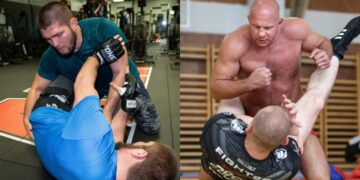
Footwork is an incredibly important part of Muay Thai. Every move you make in the ring starts with your stance whether it be striking, defending, or even clinching, and if there is an issue in this first link in the chain of movements then it will flow on to infect every technique.
To help with this we’ve decided to outline how to find the basic Muay Thai stance so that the proper technique is clearly defined. Then we’ve listed the five most common mistakes that people make with their Muay Thai footwork and listed the issues they cause so that you know exactly why a proper stance is so important.
What Should Your Stance Look Like?
There is no cut-and-dry Muay Thai stance, everyone has slightly different limb lengths that affect the placement of their feet and your posture and weight will shift depending on the techniques you are planning to use. That being said, there is a common stance that is generally given to beginners as a guide when they first start training that is fairly universal across the world of Thai Boxing, and it can be found by following the steps below:
- Starting with your feet planted together with your ankles touching, step out so that your feet are shoulder width apart and facing directly forward.
- Then, step shoulder’s width distance back with your dominant leg turning your foot so it is facing out at a 45-degree angle.
- Lift your back heel slightly so that your weight is on the ball of your foot.
- Once your heel is raised, “soften” your knees and hips so that there is a slight bend in both, and you aren’t too tense.
The 5 Most Common Mistakes
1) Feet Too Far Apart
You need to be able to quickly shift your weight if you are going to strike fast and defend against incoming strikes. When your feet are too far apart, you’ll find that it takes too long to shift your weight in order to block or step aside to catch an incoming kick. Not only will you find that your opponent’s kicks land clean on your ribs before you are able to lift your block, but your punches will also lack power as your weight won’t be able to stay above both hips when you step in to fire them.
2) Feet Too Narrow
Ideally, in most fight scenarios you want to keep your feet about shoulder width apart so that you have balance. If your stance drifts narrower than this, you’ll find that you lose balance easily and whenever you throw a rear straight punch it might feel like you are going to fall over.
This mistake is most common with beginners who’ll often turn their rear hip outwards, so their feet are planted in an “L” shape. When this happens it usually isn’t long before they have their heels standing in one straight line, as if they are balancing on a tight rope. If you do this, you’ll find that it doesn’t only affect your punches, it also slows your rear kick as your lead leg is blocking it from following a straight path to your opponent’s body. To throw the rear leg from the” tight rope” position you’ll need to throw it in a semi-circle, telegraphing it for your opponent who will have much more time to counter or defend against it.
3) Too Much Weight On One Foot
There are times when you will want to put more weight on one leg. A southpaw will often be front-leg heavy when fighting an orthodox opponent while a defensive fighter might want to put more weight back to free their lead leg for teeps and switch kicks. If you aren’t shifting your weight for a specific purpose, then you want to keep your weight based evenly over both legs so that you have more offensive and defensive options at your disposal.
Fighters who place too much weight on their front leg will find themselves an easy target for leg kicks while a fighter who places too much weight on their rear leg will struggle to fire off kicks and blocks on that side of their body with any kind of speed. So, while being heavy on one leg isn’t necessarily a bad thing, you want to choose the right time to do it and, in these situations, try not to have your feet too far apart so you can quickly adjust your weight if needed. Referencing the same video from Sean Fagan, he shows you why you should try not to put more weight on one foot.
4) Crossing Feet
In the same video by Sean Fagan, he will explain why you should never cross your feet in Muay Thai. The second you do you lose the ability to both attack your opponent and defend against them. Beginners will often cross their feet by mistake when they sidestep. Either they’ll step on the wrong foot first, crossing their feet before landing in the correct stance or their second step is too long, and they end up standing too narrow or cross-legged, needing another step to adjust.
When side-stepping, try picturing yourself as a crab scuttling across the beach. A crab can’t physically place its legs under its carapace so it needs to take many smaller steps to move laterally. Likewise, in Muay Thai you can’t move your legs across to your opposing hips unless you want to wear your opponent’s shin to your ribs.
5) Legs Too Straight
When you are in your Muay Thai stance, you want to have “soft” hips and knees, Meaning, you don’t want to stand with your joints locked straight and your muscles completely tense. Doing so means that you don’t have any explosive power ready to unload onto your opponent.
When you are fighting, try to imagine that your legs are springs. They need a little bend in them so that they can launch out straight when you kick. A completely straightened spring has no tension ready to unload and in the same way, you’ll struggle to rotate your kicks with speed or power if your legs are straightened out.
Softening your legs also helps you defensively. Having a slight bend in your waist and knees lowers your center of gravity, giving you more balance in the clinch whilst also making you harder to move if your opponent hits you. Softened hips and knees also help to lower your body position so that you are able to cover more of your ribs with your arms and legs when you are blocking, making you a smaller target for body shots.
Conclusion
In Muay Thai, you need to keep your feet and legs in the right place to be effective. If your feet are too wide, too narrow, or too straight, you’re going to have a hard time successfully attacking or defending against your opponent, who is likely to capitalize on your errors. While standing with more weight on one leg isn’t always a mistake, you need to know the right time to do it and what techniques it benefits, otherwise, your opponent will capitalize on it too.
You may also like:
How To Fight Like Tawanchai PK Saenchai
When you begin learning Muay Thai, the sheer number of strikes, skills, and positions you need to memorize can be daunting. In fact, you could spend half of your first few months of training, scratching…
Jonathan “The General” Haggerty is a British Muay Thai fighter and reigning ONE Muay Thai and Kickboxing Bantamweight World Champion. Haggerty has an aggressive, but highly cerebral, style that any fighter can learn from. Switch-hitting,…
While Muay Thai is undoubtedly a team sport and most of your training will be done in groups and under the watchful eye of a trained coach, there will inevitably be times when you need…
In Muay Thai, you need to have power in your kicks and knees if you want to dominate in the ring. Unlike other striking sports where the volume of shots landed plays a major role…
Muay Thai sweeps are a work of art. In the sport, few techniques require greater accuracy and timing, and seeing one executed with precision is truly captivating. Not only are sweeps beautiful to watch, but…
Muay Thai may be an ancient martial art but as a sport, it is always evolving. Every day, across every corner of the globe, athletes are pushing their bodies to the limit, trying to get…
In Brazilian Jiu-Jitsu, you must isolate the limb you are attacking to submit an opponent effectively. The same can be said when passing the guard. Typically, to pass the guard, a grappler must be able…
In the heart of Southeast Asia, Singapore stands as a beacon of modernity, technological advancement, and a deep-seated commitment to health and wellness. Amidst the bustling city-state’s myriad fitness trends, boxing has emerged as a…
In the rapidly evolving world of martial arts, the integration of traditional systems with modern fighting styles has become a focal point for practitioners and enthusiasts alike. At Evolve MMA in Singapore, we are at…
Having strong wrists is essential in boxing, whether you’re throwing punches at an opponent or working on a heavy bag. Your wrists carry a heavy load whenever you punch something hard, which is why boxers…
The internet has always been a huge part of mixed martial arts. MMA started to gain popularity in the early 90s, but attending live events or buying DVDs or VHS tapes was the only way…
Tawanchai PK Saenchai is a dynamic Muay Thai fighter and current ONE Featherweight Muay Thai World Champion. Despite being only 25 years old, he is already a veteran of the fight game, making his Lumpinee…


![Virat Kohli will be my favourite wicket to get in the IPL: LSG's latest recruit Naman Tiwari [Exclusive]](https://babu88sports.com/wp-content/uploads/2025/12/virat-kohli-will-be-my-favourite-wicket-to-get-in-the-ipl-lsgs-latest-recruit-naman-tiwari-exclusive-360x180.png)






























![Virat Kohli will be my favourite wicket to get in the IPL: LSG's latest recruit Naman Tiwari [Exclusive]](https://babu88sports.com/wp-content/uploads/2025/12/virat-kohli-will-be-my-favourite-wicket-to-get-in-the-ipl-lsgs-latest-recruit-naman-tiwari-exclusive-120x86.png)



![Virat Kohli will be my favourite wicket to get in the IPL: LSG's latest recruit Naman Tiwari [Exclusive]](https://babu88sports.com/wp-content/uploads/2025/12/virat-kohli-will-be-my-favourite-wicket-to-get-in-the-ipl-lsgs-latest-recruit-naman-tiwari-exclusive-350x250.png)